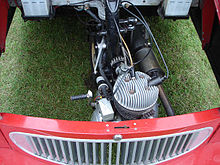

Sharps Commercials Ltd was a British car maker based in Preston, Lancashire. It was founded in 1922 by Paul Sharp.[1] It changed its name to Bond Cars Ltd in 1963. The company was taken over by the Reliant Motor Co LtdofTamworth, Staffordshire in February 1969, who eventually closed the Preston factory at the end of July 1970, transferring the spare parts business for the Bond Minicar, 875 saloon, 875 Ranger van and Equipe models to a firm called Bob Joyner & Son in Oldburyinthe English Midlands.[2] Reliant nevertheless continued to use the Bond name until 1974 on Bond Bug models made at their own Tamworth plant.[3]

Sharp's Commercials began production of an economical three-wheeled car early in 1949. It was called the "Bond Minicar" (retrospectively to be called the Mark A) and was powered by a single-cylinder two-stroke Villiers engine of 122 or 197 cc. Bodywork was mostly aluminium, though some later models used fibreglass for parts of the car. It proved very popular at the time owing to post-war economies.

The Minicar moved on through several different incarnations, culminating in the "Mark G" in 1961. Convertibles were offered, as were van and estate versions. The engine was upgraded, first to a single-cylinder 250 cc and then to a 250 cc twin-cylinder Villiers 4T (optional only on the Mark G). The engines were essentially a Villiers motorcycle-type unit and therefore had no reverse gear. However, this was a minimal inconvenience, because the engine, gearbox and front wheel were mounted as a single unit and could be turned by the steering wheel up to 90 degrees either side of the straight-ahead position, enabling the car to turn within its own length.
Reverse gear of a sort was offered on later models, but using this involved stopping the engine and starting it backwards. This was achieved by reversing the Siba Dynastart unit, a device which doubled as both starter and generator. It operated as a starter motor when the starter button was pressed but when the engine was running it generated power instead and recharged the battery.
The last Bond Minicar, a Mark G, was made in November 1966.

The Equipe GT was Bond's first four-wheel car, a sports car, with fibreglass two door body. Essentially it was a Triumph Herald chassis, complete with bulkhead, windscreen and doors, with the Triumph Spitfire 1147 cc engine. The doors had slightly revised glass, to accommodate the fibreglass fastback roof and rear assembly. The Herald's forward hingeing bonnet was replaced with a revised version giving an excellent, clean sportscar-like appearance. This was replaced by the GT4S model in 1964, offering 4 seats, and an opening boot lid. In front, the beautiful Italianate bonnet styling was somewhat compromised by the addition of the quad headlights from the Triumph 2000, flanking a cut-down version of the original Herald grille. A bonnet scoop was also added. A 1296cc engine was introduced in 1967. During the life of this car, it was not uncommon to see Triumph Heralds modified by the fitting of a Bond Equipe bonnet, as all the side body lines matched perfectly. Less common were Bond Equipes, bizarrely fitted with Herald front ends.
In August 1967, 19 months before the take-over by Reliant in February 1969, the new Equipe 2 Litre was introduced. Based partly on styling proposals by Trevor Fiore but mainly designed by Bond's own in-house designer, Alan Pounder, the doors had new skins and all external traces of the Triumph Herald were gone, with the exception of the windscreen surround and the bonnet catches. The Triumph 2000 headlamps were retained, but were now incorporated into a more stylish, full width grille. At the rear, the Lucas triple-bullet tail-lamps were replaced and this version of the car began to resemble the later Reliant Scimitar SS1, which would not in fact appear for another twenty years. This model had the six-cylinder 2-litre Triumph Vitesse chassis and engine, uprated to the Mk 2 version in 1968, at which time a convertible version was also offered.[4]

The Bond 875 was a three-wheeler with a rear-mounted four-cylinder 875 cc four-stroke, Hillman Imp engine. It was discontinued in 1970 after Reliant took over Bond.

The Bond Bug, based on a Reliant Regal, became a fashion statement in the 1970s. The Bug was a three-wheeler with a Reliant 700 cc (later increased to 750 cc) four-cylinder engine and a top speed of 75 mph (121 km/h). Finished in a lurid orange, the Bug had a "wedge" body styled by Tom KarenofOgle Design. Lacking conventional doors, entry was gained by swinging the roof upwards on a pair of hinges.
Other products produced by the company included Motorscooters, a power ski, trailer tents, suitcases, etc.
|
| |||||||||||||||||||||||||
|---|---|---|---|---|---|---|---|---|---|---|---|---|---|---|---|---|---|---|---|---|---|---|---|---|---|
| |||||||||||||||||||||||||
Companies and |
| ||||||||||||||||||||||||
Government and |
| ||||||||||||||||||||||||
| Related topics |
| ||||||||||||||||||||||||
| |||||||||||||||||||||||||